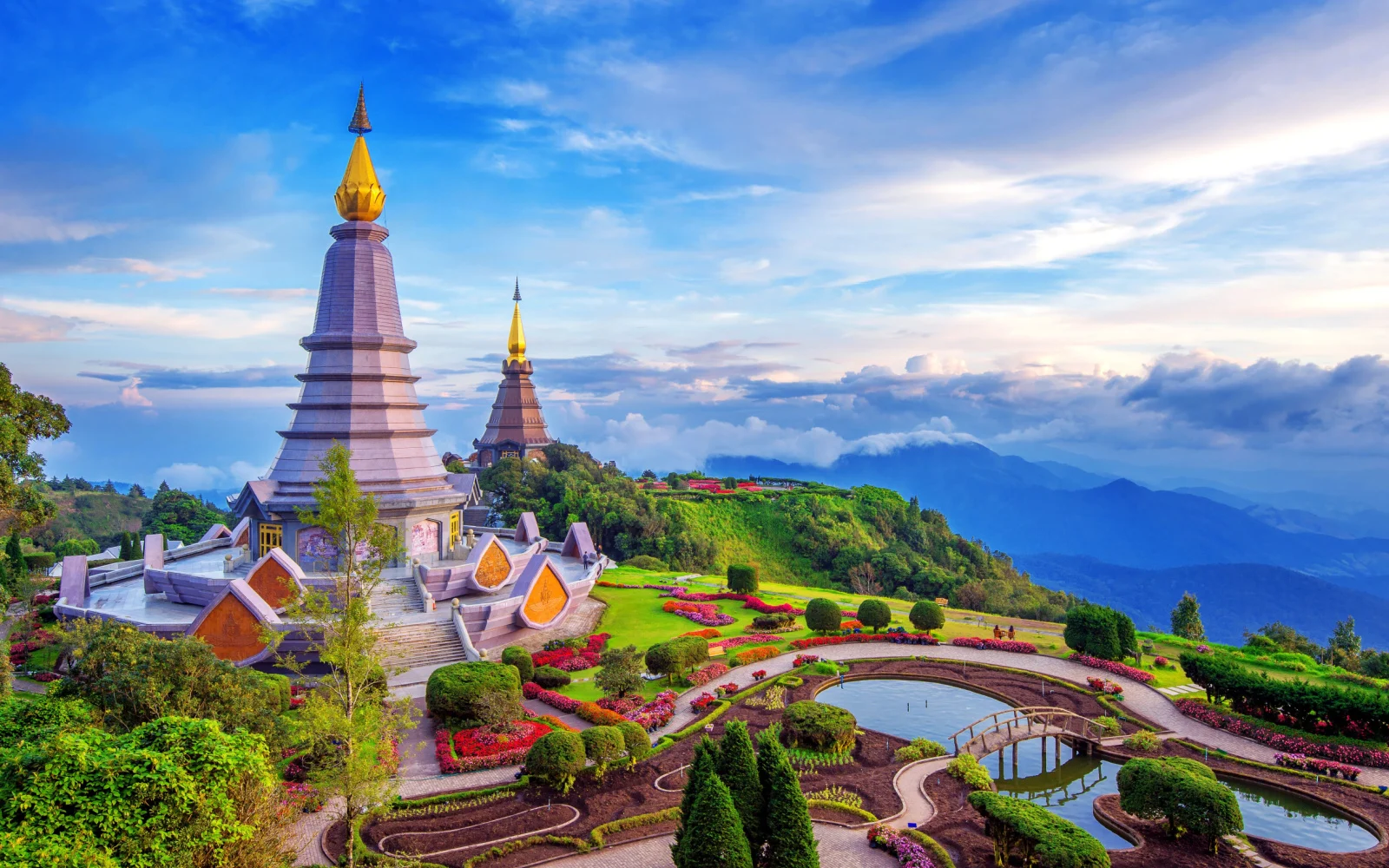What's the best time to visit Chiang Mai?
The best time to visit Chiang Mai is during mild December and January in the dry season. This pinnacle period is popular with tourists thanks to cooler temperatures in the low-to-mid 80s, clear skies, great sightseeing and weekend street fairs, big cultural festivals in the hill villages, and the gilded Buddhist temples of the Old City.
Taking a trip through the mountainous land of temples in Thailand’s Chiang Mai? This ancient city is filled with 300+ royal and ruined wats, or temple complexes, and ruins of its original moats and walls in the Old City that offer a peek into the distant past.
But intense seasonal heat, rains, and annual agricultural “burning season” make it essential to find out the best time to visit Chiang Mai. Chiang Mai is one of the most popular spots for tourists in northern Thailand because of its high concentration of these holy Buddhist complexes.
With so many to explore, From the gilded 14th-century Wat Phra Singh (The Golden Temple) to Wat Phra That Doi Suthep with storied relics of the Buddha, it’s a place where travelers can spend weeks venturing through the city and into the surrounding countryside to see ancient wonders.
The time of year you visit makes a big difference, though. Your experience could be incredible with balmy weather, sunny skies, and abundant exploration and sightseeing. In the wrong season, it could be choked with thick smoke, heavy rains, or sweltering heat and humidity.
Let’s take a look at the best time to visit Chiang Mai, along with the cheapest, least busy, and worst time of year to go. We’ll show you special cultural festivals and events for each season, weather trends, and average pricing on accommodations to help you pinpoint the right time to explore Chiang Mai.
Overall Best Time to Visit Chiang Mai
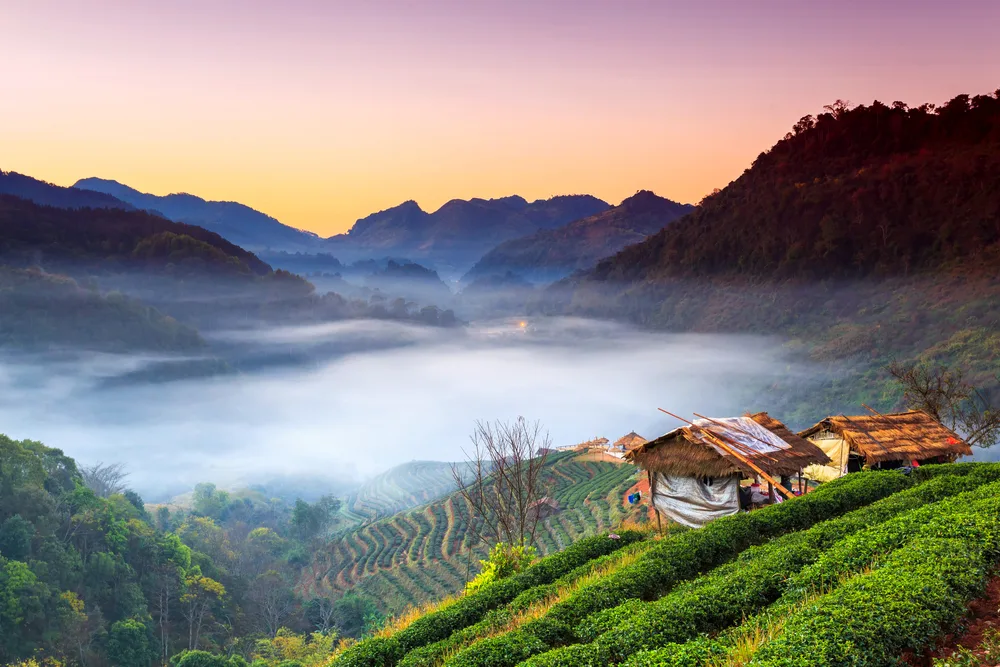
Bambell/Shutterstock
The best time to visit Chiang Mai is December through January. Both months offer sweet relief from the heat, rain, and looming burning season.
Northern Thailand nights are chilly in December and January, but the days are mild and warm with dry conditions and blue skies overhead. With almost no rainfall and highs in the low-to-mid 80s, this is an idyllic time to explore the temples and social hubs of Chiang Mai.
- December: 61–83°F; 1 rainy day
- January: 59–85°F; 0-1 rainy days
With spectacular weather, there’s nothing to stop you from getting out and enjoying everything Chiang Mai has to offer in December and January. The infamous agricultural burning season doesn’t begin in earnest until February, so air quality is good and visibility from mountain overlooks is at its best.
Since this is the peak season, crowds will be at their annual high point during these balmy months — you can count on crowds at the most popular and sacred temples, so be sure to start your sightseeing early.
But there are so many accommodations in and just outside Chiang Mai that you won’t struggle to find a place to stay in December and January.
Hotels and accommodations are at their most expensive during these months, but favorable exchange rates mean the prices are still crazy-affordable during the peak season. Take a look at nightly rate averages we’ve sourced from Google Hotels data:
- December: $86/night
- January: $73/night
In the walled Old City and up in the mountains, check out some of the most famous temples in Chiang Mai, like Wat Phra Singh with its golden walls, mosaic sanctuary, sacred Phra Buddha Sihing statue, and gilded carved naga (serpent) statues.
Wat Chedi Luang (Temple of the Royal Stupa) features 4 naga-flanked stairways, a jade replica of the ancient Phra Kaew Emerald Buddha, and a chedi guarded by elephant sculptures.
This time of year, the Queen Sirikit Botanical Garden and Rajapruek Royal Park are both in full bloom with lots of floral-themed festivities taking place. Stroll the paths through landscaped grounds teeming with lush growth and blossoms.
Head to a night bazaar, like Chiang Mai Night Bazaar from Th Loi Kroh to Th Tha Phae streets or Kalare Night Bazaar on the other side of the street, to pick up food and souvenirs from local vendors and experience authentic Thai culture.
Since this is the period with the best weather, some really incredible festivals and cultural events happen during December and January:
- Nimmanhaemin Arts and Crafts Fair (early Dec) takes place on the lively Nimman Promenade as vendors and local craftsmen set up with handicrafts, art, and food along the street and in Think Park across the road
- Bo Sang Umbrella & Sankampang Handicrafts Festival (Jan) takes place over 3 days as local artists and vendors set up with hand-painted paper parasols and more in nearby Bo Sang Village
With clear skies, warm weather, and so many cultural events going on in December and January, you won’t find a better time to visit Chiang Mai to fully experience its historic significance and wonder.
Cheapest Time to Visit Chiang Mai
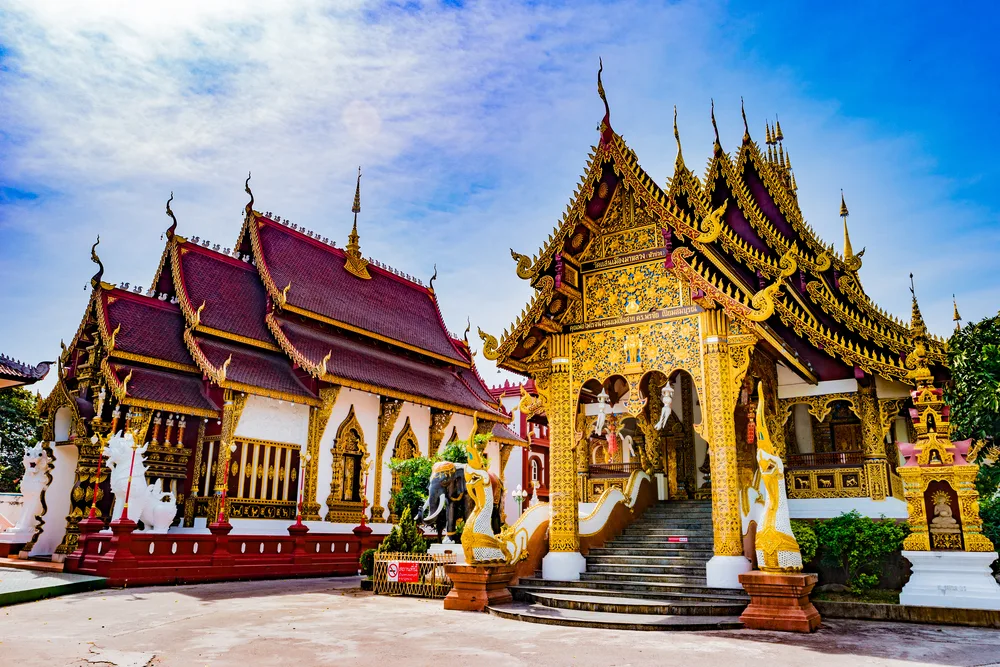
Romas_Photo/Shutterstock
The cheapest time to visit Chiang Mai is during the months of February, May, September, and November. Since hotels are generally cheap year-round here, the best time to visit on a budget is when airfare to Chiang Mai is cheap.
Looking at airfare data from the United States to Chiang Mai on Skyscanner, we found that the cheapest overall times to visit are when round-trip flights dip below $900 — sometimes far below (like in May):
- February: $843+
- May: $640+
- September: $826+
- November: $880+
Compare these prices to the higher airfare in months like June ($2,866+) or January ($1,242+) and it’s easy to see why some people prefer coming when flight prices take a dip.
There are several benefits to coming during any of these months beyond the affordable prices. February and November are nice and dry, May is one of the least busy months to visit, and September sees smaller crowds due to its frequent showers and storms.
On the flip side, May and September are incredibly wet months (especially September) that can interfere with your sightseeing and temple tours. February is the start of the smoky burning season, and November is one of the busiest months of the year in Chiang Mai.
Here’s a look at what you can expect during these months, weather-wise:
- February: 62–90°F; 0-1 rainy days
- May: 76–93°F; 14-15 rainy days
- September: 74–88°F; 16 rainy days
- November: 67–86°F; 3-4 rainy days
The good news? The rainy season in Chiang Mai tends to look like short afternoon showers and thunderstorms that pass over the area quickly, within an hour or two. In September, though, it’s not uncommon for it to rain all day and cause some flooding.
April, May, and June are the months with the lowest average hotel prices in Chiang Mai, but things aren’t much higher in February, September, and November, as you can see from data taken from Google Hotels below:
- February: $71/night
- April: $42/night
- May: $39/night
- June: $41/night
- September: $45/night
- November: $76/night
Take a walk down the the lively Nimman Promenade — “Coffee Street” — on Nimmanhaemin Road to experience one of the hubs of Chiang Mai, where cafes, noodle shops, art galleries, and upscale restaurants line the road as people mill about.
Visit the Saturday (Th Wualai) Walking Street or the busier Sunday Tha Phae (Th Rachadamnoen) Walking Street in the Old City to sample local snacks and foods, browse colorful trinkets and jewelry, or pick up souvenirs.
During these weekend events, the temple courtyards are packed with vendors and food markets along the way and people come out in droves to shop and socialize. It’s a great time to see Wat Phra Singh, Wat Phantao, and Tha Phae Gate.
On the Saturday Walking Street (Th Wualai), you can also visit Wat Srisuphan, the Silver Temple, adorned with shining silver, aluminum, and nickel for a mirror-like shine during the day and incredible effects when it’s lit up at night.
On the Sunday Walking Street (Th Rachadamnoen), you can hit Akha Ama Cafe for excellent coffee grown in the nearby jungles with Thai snacks and wi-fi.
Keep an eye out for some of the colorful festivals and fairs that happen during the cheapest months to visit, like:
- Ornamental Flower Fair (early Feb) is held in Suan Buak Haad Public Park in the southwestern part of the Old City, with ornate floats decorated entirely with fresh flowers in Thai cultural designs and figures and vendors selling plants, flowers, and seeds
- Māgha Pūjā Day (mid-Feb) is a Buddhist festival held on February’s full moon that commemorates a famous sermon by Buddha with the 3 fundamental teachings (purify the mind, do good, abstain from evil); people visit temples, hold candlelight processions, and bring flower and incense offerings
- Visakha Bucha Day (May) honors Buddha’s enlightenment with packed temples as locals bring flowers, fruit, and incense on May’s full moon
- Inthakin City Pillar Festival (May) takes place at Wat Chedi Luang’s city pillar with a huge procession through the Old City as people bring a sacred Buddha image to rest in the courtyard, where offerings are placed
- Loy Krathong/Yee Peng Festival (Nov) is a famous 3-day festival in Chiang Mai (and surrounding Thailand) featuring candles and flowers sent out on the river in banana plant boats, floating lanterns, and colorful parades
You can always adapt to the less-than-ideal weather conditions and crowds in November if your main goal is saving money on the trip of a lifetime to Chiang Mai. You’ll be able to immerse yourself in the local culture by venturing out to markets, walking streets, and restaurants this time of year.
Least Busy Time to Visit Chiang Mai
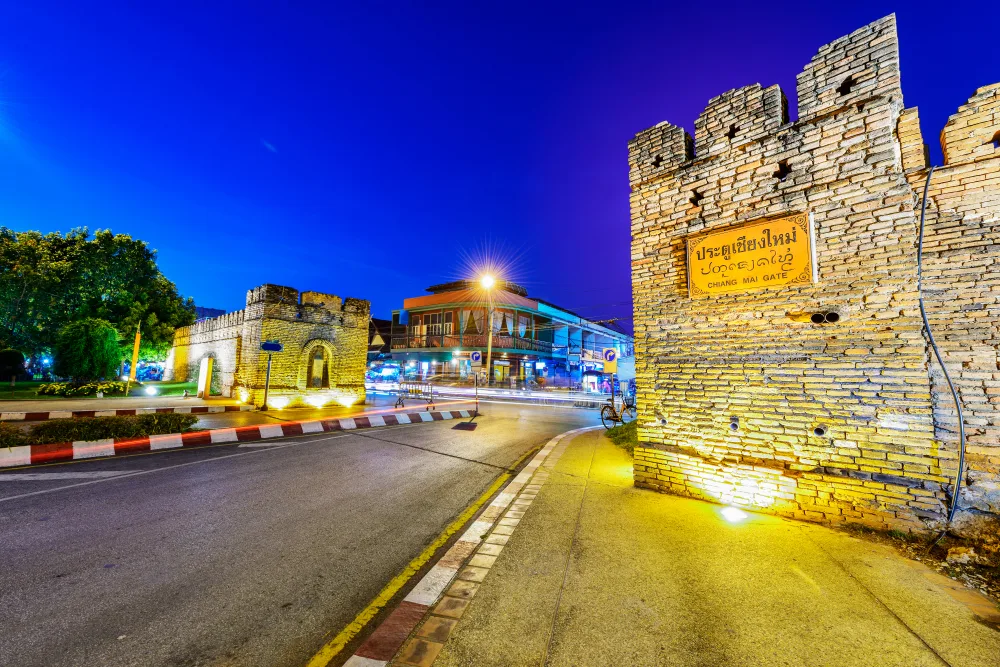
aphotostory/Shutterstock
April, May, and June are the least busy months to visit Chiang Mai. As the burning season wraps up, it’s hot, humid, and rainy across Chiang Mai during this less-crowded season.
Highs top out around 97°F in April, dropping steadily to 90°F by the time June arrives. It’s muggy in April, but very humid once May and June roll around. That makes it harder to enjoy sightseeing at temples and historic landmarks.
- April: 74–97°F; 7 rainy days
- May: 76–93°F; 14-15 rainy days
- June: 76–90°F; 13 rainy days
But if you’re looking to cool off a bit in the 90°F+ weather, you can always head up into the mountains around Chiang Mai. Go up into the Doi Ang Khang mountains and see the countryside.
Visit the Hmong Doi Pui mountain village nearby to see how Thai hill tribes lived — and still live — in a beautiful setting that’s now part of Doi Suthep-Pui National Park. It’s home to Wat Phra That Doi Suthep looking out over Chiang Mai from its mountain perch, surrounded by trees and wildlife.
Along the way, you’ll find acres of rice paddies, hill tribe villages like Ban Mai Nong Bua, and the Royal Agricultural Station with beautiful fruit trees, bursts of pink sakura (cherry blossoms), and roses in bloom.
Take in some live music and watch locals gather to enjoy smooth jazz at North Gate Jazz Co-Op on Sri Poom Road near Wat Kok Moli. Crowds pack the place on weekends, so grab a sidewalk table early in the evening and enjoy the music all night long.
It’s just your luck that the least busy time to visit is also the period with the cheapest average rates on hotels and accommodations around Chiang Mai! Here’s what we found by averaging Google Hotels rate data across the region:
- April: $42/night
- May: $39/night
- June: $41/night
Flight prices can be very expensive this time of year, however, with the exception of May (one of the cheapest months to fly to Chiang Mai from the U.S.).
From April to June, some of the year’s biggest events and festivals take place around Chiang Mai, including Visakha Bucha Day, Inthakin City Pillar Festival (both detailed in sections above) and Thai New Year.
April’s Songkran is the Thai New Year celebration with traditional music, parades, and massive water fights where locals use buckets, squirt guns, balloons, and more to soak each other as they welcome the new year.
Worst Time to Visit Chiang Mai
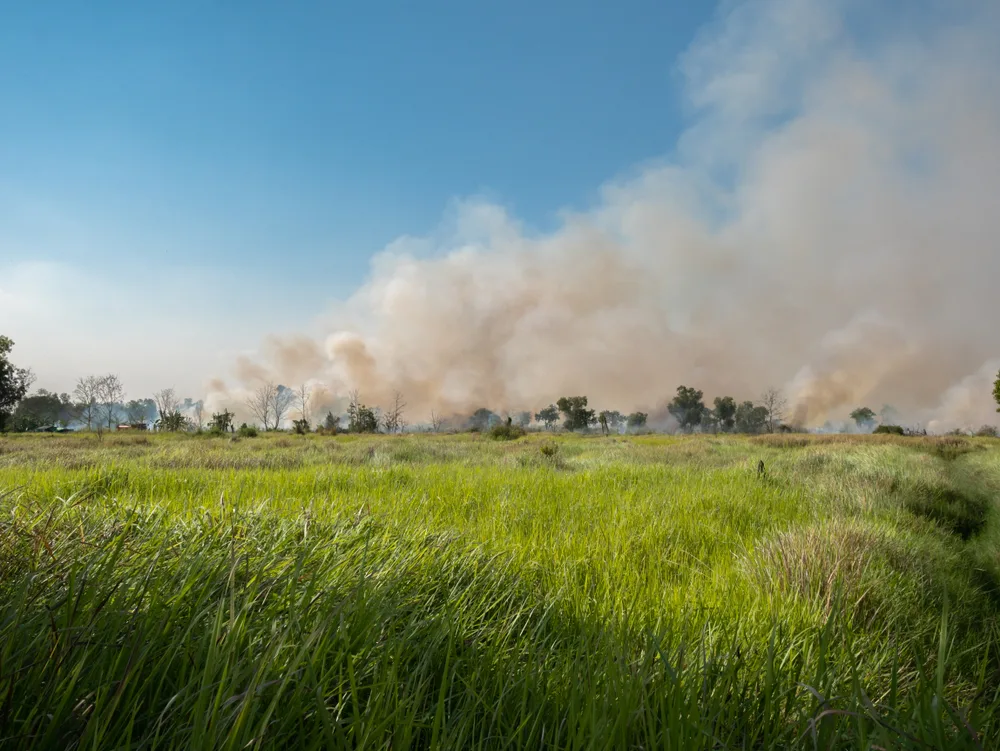
Khomson Srisawasdi/Shutterstock
February to April is the worst time to visit Chiang Mai because of the sweltering heat and agricultural burning season for Northern Thai farmers. The entire city and region is choked with thick smoke and air pollution this time of year.
Burning season for farmers revamping their fields with slash-and-burn practices that blanket the region in thick smoke and make it almost unbearable to visit. In 2024, Chiang Mai was the world’s most polluted city for a solid week due to the burning!
My wife and I visited Chiang Mai in March and experienced the heat and burning season smoke firsthand — trust me, it’s hot and uncomfortable this time of year. I got a sinus infection from all the air pollution! We headed up into the hills to see the elephants at Mae Sa Elephant Camp to escape some of the heat.
- February: 62–90°F; 0-1 rainy days
- March: 68–95°F; 2 rainy days
- April: 74–97°F; 7 rainy days
There’s a lot to see and do during these months, prices are pretty cheap, and the area is less crowded, but you’ll be dealing with temperatures over 90°F (approaching 100°F in April) and smoke that irritates your eyes, nose, and throat the whole time.
Take a look at how much you can expect to pay for a hotel room between February and April, according to data we’ve averaged from Google Hotels:
- February: $71/night
- March: $64/night
- April: $42/night
On the bright side, there are some really neat festivals and cultural events happening in Chiang Mai during the hot burning season. You might want to visit the Ornamental Flower Fair or Māgha Pūjā Day (Feb), visit the Mae Sa Elephant Camp on Thai Elephant Day (Mar 13), or attend Thai New Year celebrations in April.
It’s far from ideal to come to Chiang Mai between February and April, but it doesn’t have to be a deal-breaker if you’re dead set on coming and these are your only available travel dates.
Chiang Mai by Month: What to Expect
January
One of the best months to visit Chiang Mai, January brings mild highs around 85°F with roughly 1 rainy day. In nearby Bo Sang Village, a 3-day umbrella and handicrafts festival takes place this month. Hotels are around $71/night this month as travelers flock to Chiang Mai.
February
February is when the burning season begins to affect the area significantly. Hotels charge around $71/night this month and airfare is some of the lowest of the year. With highs around 90°F and almost no rainfall, crowds are small. The Ornamental Flower Fair in early February brings colorful floats covered in blooms and Māgha Pūjā Day happens on the full moon with temple celebrations.
March
Burning season continues in March, when highs reach a sweltering 95°F and it rains just a couple of days this month. People head to the nearby mountains to escape the heat and smoke, while Thai Elephant Day draws people to a nearby elephant sanctuary. Hotels are about $64/night in March.
April
April marks the end of burning season, right as the rainy season begins. With 7 rainy days and the hottest temperatures of the year (around 97°F), conditions aren’t perfect, but hotels are cheap at just $42/night on average and total visitor numbers are very low. Thai New Year celebrations, Songkran, happen this month and draw more visitors.
May
In May, the average price of hotel rooms in Chiang Mai is the lowest of the year at $39/night, while airfare prices also hit their annual low this month. That coincides with highs around 93°F, lots of rain (14-15 rainy days), and Buddhist festivals like Visakha Bucha Day and Inthakin City Pillar Festival.
June
Quiet June sees fewer visitors in Chiang Mai and cheap accommodation prices continue (averaging $41/night) with hot weather around 90°F most days. It rains 13 days of the month on average, so it’s wise to plan sightseeing around the storms and showers that tend to happen in the afternoon.
July
With steadily cooling temperatures (around 88°F highs this month) and 14-15 rainy days, July is damp and humid. Visitor numbers are still low with the challenging weather conditions, hotel rooms are quite cheap at around $46/night, and Buddhist festivals like Ashhna Bucha Day and Khao Phansa Day happen this month.
August
Rainfall peaks in August with about 18 rainy days this month, and the afternoon showers sometimes turn into day-long affairs. With highs around 88°F, it’s warm to hot with more challenging sightseeing as roads get muddy and often flood. Hotels charge about $47/night for rooms this month.
September
As the heavy rains continue in Chiang Mai, September sees similar weather to August with highs averaging 88°F and 16 rainy days. Hotels cost roughly the same — about $45/night — and airfare is cheap this month. But most tourists stay away, waiting for drier weather in the coming months.
October
The number of visitors to Chiang Mai begins to increase in October, when the rains finally begin to level off with 10 rainy days this month. Highs are still around 88°F and hotels are affordable at an average $50/night in October.
November
With some of the most affordable airfare of the year but higher average hotel prices around $76/night, November still counts as one of the cheapest months to visit with fair weather (3-4 rainy days and highs around 86°F. One of the most revered festivals in Chiang Mai happens: Loy Krathong, a 3-day Festival of Lights with parades and banana plant boats holding flowers and candles on the river.
December
One of the best times to visit Chiang Mai, December brings cooler temperatures with highs around 83°F and just 1 rainy day on average. Hotel prices reach their annual peak, but still hover around $86/night. Check out the Nimmanhaemin Arts and Crafts Festival on the lively Nimman Promenade and Think Park early this month.
Frequently Asked Questions
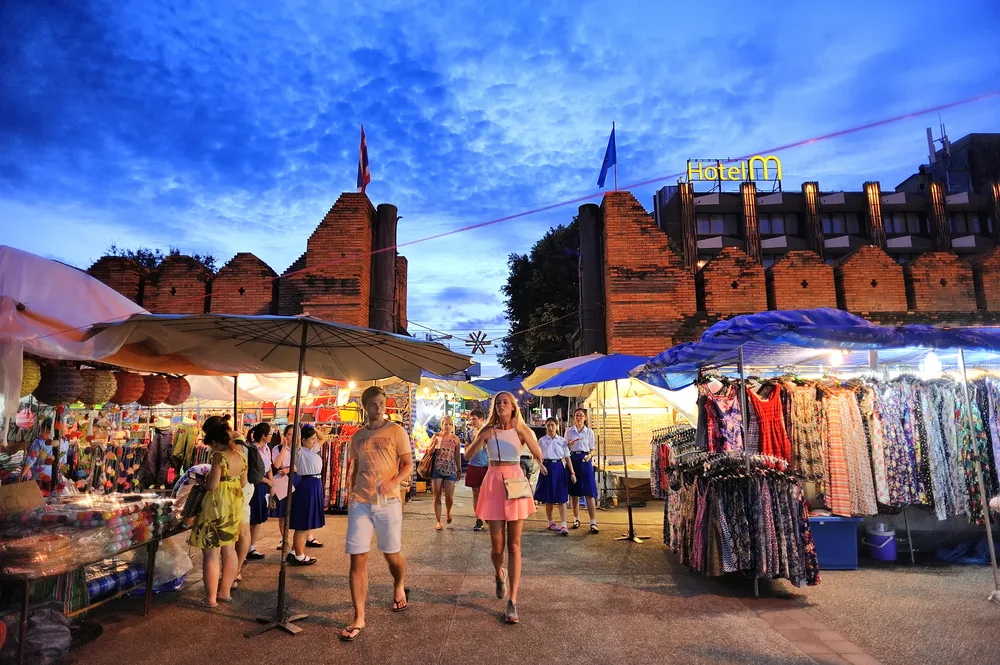
Chiang Mai Thailand – August 27 , 2015 : Tha-Pae Gate multi courtyard of the city often has night markets. There are souvenirs for sale, food and beverage store sales to tourists/501room/Shutterstock
It’s no secret that Chiang Mai is an incredible place to visit, but you might be left with a few more questions about planning your trip at the right time. Check out the most frequently asked questions below to learn more!
What is the best month to visit Chiang Mai?
December is the best month to visit Chiang Mai overall. With sunny weather and mild temperatures peaking around 83°F this month, there’s almost no rainfall. The Nimmanhaemin Arts and Crafts Festival happens on bustling Nimman Promenade and nearby Think Park this month, while Chiang Mai hotels cost just $86/night on average in December.
How many days in Chiang Mai is enough?
Plan on spending at least 4-5 days in Chiang Mai, which is usually enough to explore the Old City temples and venture out into the mountains to see more Buddhist temple complexes, the lush Doi Suthep-Pui National Park, ancient hill tribe villages, and the nearby Mae Sa Elephant Camp.
Which month is better to visit Thailand?
The months of November to April are better to visit Thailand because they’re typically dry with cooler temperatures than the months from May to October (rainy or monsoon season). Thai New Year celebrations (Songkran) happen each April across Thailand with grand parades that are fun to attend.
Is it better to go to Phuket or Chiang Mai?
Chiang Mai offers a more culturally distinct visit to Thailand than Phuket because it’s home to over 300 Buddhist temples -- many ornate and gilded with naga serpents and elephants guarding sacred Buddha statues and relics. Phuket, a rainforested island with beautiful beaches, is beautiful with glitzy resorts, nightclubs, and markets.
Why is Chiang Mai so famous?
Chiang Mai is famous for its huge array of ancient Buddhist temples and sacred sites. With more than 300 in the Old City and surrounding region, there are more temples clustered around Chiang Mai than anywhere else in Thailand. Its mountainous, lush setting and bustling town with lively shopping streets makes it stand out.
So, What’s the Best Time to Visit Chiang Mai?
| 👍 Best Time to Visit | December-January |
| 💲 Cheapest Time to Visit | February, May, September, November |
| 🗓️ Least Busy Time to Visit | April-June |
| 👎 Worst Time to Visit | February-April |
December and January are, by far, the best months to visit Chiang Mai. Cooler temperatures in the low-to-mid 80s, clear skies with almost no rain, and big cultural festivals make it our favorite time to visit.
Plan your visit for February, May, September, or November for the cheapest airfare, while April, May, and June offer the lowest prices on hotels (but they’re always quite cheap). May is the cheapest month to visit overall with the lowest average airfare and hotel rates.
Try to come between April and June for the smallest crowds, but prepare for sweltering heat and burning season smoke in April, then hot weather and lots of rain in May and June.
We recommend avoiding any month between February and April simply because the smoke from the agricultural burning season can make it unbearable to be outside and enjoy sightseeing.
If it comes down to these months or a rainy month, choose the rainy one — showers don’t usually last all day, at least until August and September come. Chiang Mai is always a spectacular place to travel, but you’ll enjoy it much more when you go during the more idyllic months of the year!



